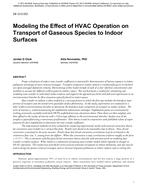
DE-13-C052 — Modeling the Effect of HVAC Operation on Transport of Gaseous Species to Indoor Surfaces
- Comments Off on DE-13-C052 — Modeling the Effect of HVAC Operation on Transport of Gaseous Species to Indoor Surfaces
- ASHRAE
Proper calculation of indoor mass transfer coefficients is essential for determination of human exposure to indoor pollutants and design of some removal strategies. Transport of species to indoor surfaces is traditionally given in the form of a space-averaged deposition velocity. Shortcomings of this model include its lack of a clear reference concentration and inability to account for different airflow patterns within a space. This work presents a method for calculating and modeling mass transfer to individual indoor surfaces and supports the approach put forth with full-scale experiments in an environmental chamber for flow situations typically found in indoor spaces.
Mass transfer to surfaces is often modeled as a two-step process in which the first step includes the boundary layer portion of transport and the second term quantifies surface phenomena. In this study, experiments are conducted in a 60m³ walk-in environmental chamber to determine the boundary layer component of transport to indoor surfaces. The term of interest, k, is determined using the naphthalene sublimation technique. Naphthalene plates are constructed by melting commonly available moth balls (99.9% naphthalene) onto aluminum sheets. These sheets are then weighed, and then affixed to the surface of interest with a Velcro-type adhesive in the environmental chamber. Surface area of the samples is quantified using a non-contact profilometer. Film theory is used in conjunction with published values of vapor pressures for pure naphthalene to determine the mass transfer coefficient.
The experimental methods are first validated by comparing experimental results with natural convection theory for convective mass transfer on a vertical flat plate. Results were found to be reasonably close to theory. Next, forced convection is analyzed in the same manner. Results show that forced convection correlations may be correlated to the volumetric flow rate, V, issuing from the diffuser. When this convention is used, correlations conform roughly to the form vt=C*V0.8. This is consistent with flat plate forced convection theory and also with previous work on modeling heat transfer to indoor surfaces. What results is a refinement of existing mass transfer models which responds to changes in HVAC operation. This model may provide for more accurate estimates of exposure to indoor pollutants, and also may be used to design for passive removal strategies, such as removal of gaseous pollutants at indoor surfaces such as ceiling tiles.
Citation: ASHRAE Conference Papers, Denver, CO
Product Details
- Published:
- 2013
- Number of Pages:
- 9
- File Size:
- 1 file , 500 KB
- Product Code(s):
- D-DE-13-C052

